75 years ago today, in the morning of Sunday 2 September 1945, the Japanese representatives signed the Instrument of Surrender, which officially ended the Second World War. The Second World War in the Far East had started with Japan’s attack of the American naval base at Pearl Harbor in the morning of Sunday 7 December 1941. The attack had led to the United States’ formal entry into World War II on the next day. This event in the Far East had made the Second World War truly global.
During the first part of the war, British colonies in the Far East – Malaya, Hong Kong and Burma – and Siam were overrun by the Japanese Southern Expeditionary forces. However, about six months after Pearl Harbor, an important turning point in the Pacific campaign allowing the United States and its allies to move into an offensive position occurred: the battle of Midway, in June 1942. By the first half of 1945, Okinawa was to be a staging area for Operation Downfall, the Allied invasion of the Japanese Home Islands. The Pacific War came to an end with the atomic bombing of Hiroshima and Nagasaki on 6 and 9 August 1945 respectively.
There are many theories about what caused Japan to surrender. According to the ‘traditional narrative’, the atomic bombs were the cause of the Japanese surrender. The ‘revisionist historians’ argue that Japan was already ready to surrender before the atomic bombs. However, in this blog I will not be going through the debate between those two camps, but I will highlight the crucial role the Soviet Union played in the termination of the Second World War.
The Neutrality Pact
The Soviet Union had an interest in the Far East long before the Second World War. By the 1930s, Stalin’s Soviet Union and Imperial Japan both viewed themselves as rising powers with ambitions to expand their territorial holdings. In addition to a strategic rivalry dating back to the 19th century, they now nursed an ideological enmity born of the Bolshevik Revolution and the ultraconservative military’s growing hold on Japanese politics.
In 1932, after the Japanese invasion of Manchuria and the establishment of the ‘puppet state’ of Manchukuo, Soviet-Japanese relations further deteriorated after Japan signed the Anti-Comintern Pact with Hitler’s Germany in November 1936, which was designed as a defence against international communism. Japan turned its military interests to northeast China, a region bordering the Soviet Far East, and disputes over the demarcation line led to growing tensions with the Soviet Union.
The Soviet-Japanese border conflicts lasted until 1939 and the Battles of Khalkhin Gol, which saw the Japanese defeated. With the German invasion of France and the Low Countries and the subsequent expansion of the Axis Powers in Europe, the Soviet Union, anxious not to face two fronts at the same time and to safeguard its eastern border, signed the Soviet-Japanese Neutrality Pact on 13 April 1941.
The Neutrality Pact proved beneficial for both countries. The assurance of Soviet neutrality encouraged Japan towards Southern expansion and the invasion of the European colonies in Southeast Asia. Likewise, the absence of a Japanese threat enabled the Soviets to move large forces from their Far East region and concentrate them on the European theatre of war.
Pearl Harbor
After the Imperial Japanese Navy Air Service attack on Pearl Harbor, American policy makers tried to persuade the Soviet Union to join them in the fight against Japan. Cordell Hull, the American Secretary of State, met with the Soviet Ambassador, Maxim Litvinov, a few days after the Pearl Harbor incident. According to reliable sources, he said, ‘Japan, notwithstanding the terms of the Russo-Japanese agreement, was under the strictest commitment to Germany to attack Russia and any other country fighting against Germany whenever Hitler demanded’ (The memoirs of Cordell Hull).
During a British War Cabinet meeting, the Joint Intelligence Sub-Committee reported that there had been reports from unknown sources that ‘the Japanese are strengthening their forces in the North at the expense of other theatres of war’, however it was unknown whether these were precautionary movements of troops or preparations to attack Russia (CAB 79/21/37). Even though all of these reports seem to be scant information, they show that the Allies were trying to persuade the Soviet Union to participate in the war against Japan. However, Stalin still adamantly refused any participation with the war against Japan, to avoid war on two fronts.
The importance of the Soviet Union
The British Joint Planning Staff (JPS) realised that sooner or later Japan would seek to remove the danger of the Soviet Union at the first opportunity. The JPS estimated that an attack by the Japanese on the Soviet Maritime Provinces would be a grave danger to Soviet efforts against Germany in Europe.
The JPS therefore drew up a plan. This ‘Appreciation of the War against Japan’ consisted of five courses, any of which would ultimately destroy Japan’s ability to continue the war. Of these five courses, three of which heavily depended on the participation of the Soviet Union, as it was the only country within air range of vital areas in Japan and from which an advance could be made into Manchukuo, Korea and North China. Its proximity to Japan provided excellent facilities for submarine operations against Japanese coastal shipping and in the Yellow Sea. Hence the JPS concluded that in order to defeat Japan, the Soviet Union’s entry into the war was of the utmost importance.
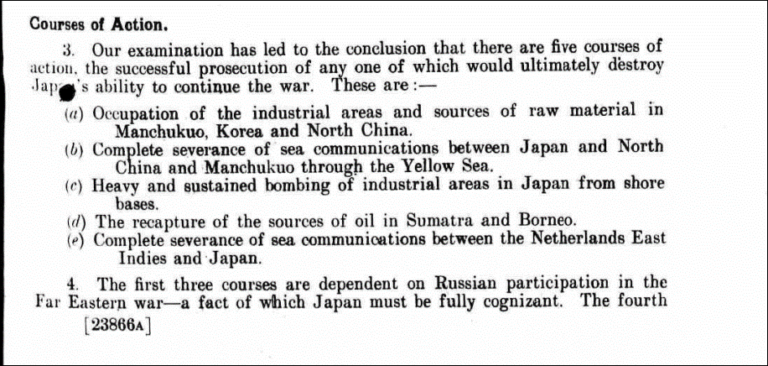
The Tehran and Yalta Conferences
After the Germans were defeated at the battle of Stalingrad at the beginning of 1943, Stalin began to build up Soviet forces in North East China. In November of the same year, Stalin showed signs of willingness to participate in the war against Japan, by verbally agreeing, at the Tehran Conference, that the moment Germany collapsed, the Soviet would join in defeating Japan.
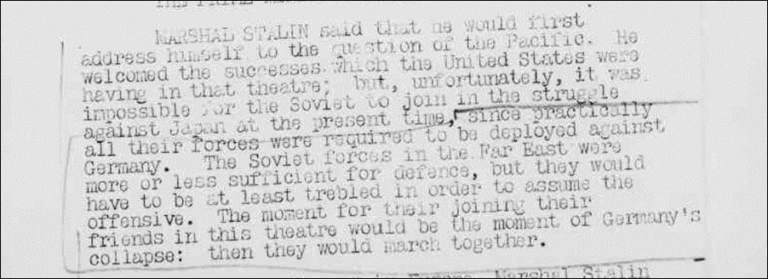
In the first week of February 1945, ‘The Big Three’ met again at Yalta, a resort city on the south coast of the Crimean peninsula, to discuss the post-war reorganization of Germany and Europe. In this meeting, the pledge that Stalin made at Tehran was confirmed. Stalin agreed that the Soviet Union would enter the war against Japan three months after Germany’s surrender, and in return the Soviets would be granted a sphere of influence in Manchuria following Japan’s surrender. This included the Southern part of Sakhalin as well as the Kurile Islands, which Japan had seized during the Russo-Japanese War in 1904-05, a lease at Port Arthur, and a share in the operation of the Manchurian railroads.
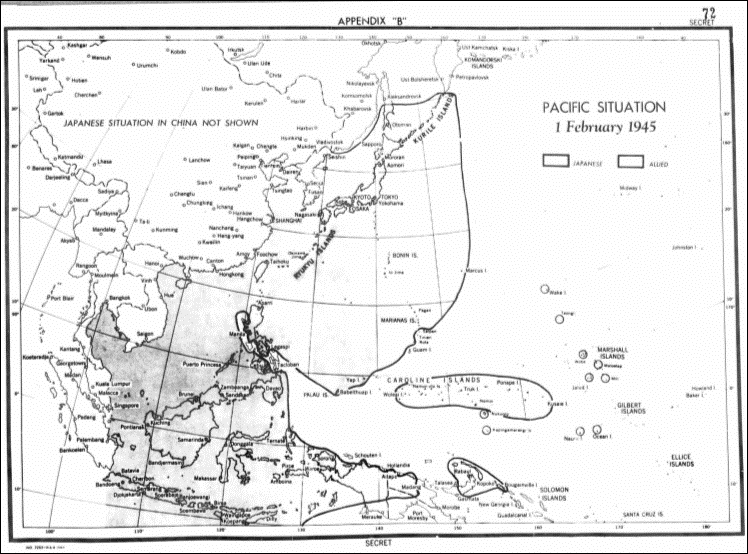
However, a few months after the conclusion of the Yalta Conference, the situation of the war in the Pacific had changed in favour of the United States. In March 1945, the US Marine Corps had successfully secured Iwo Jima and in the following month the battle of Okinawa had begun, causing the Japanese heaviest and most powerfully armed battleships Yamato to be sunk off the Ryūkyū Islands. In April, after the death of President Roosevelt, Truman became president, and there was a marked shift in the attitude towards the Soviet entry into the war.
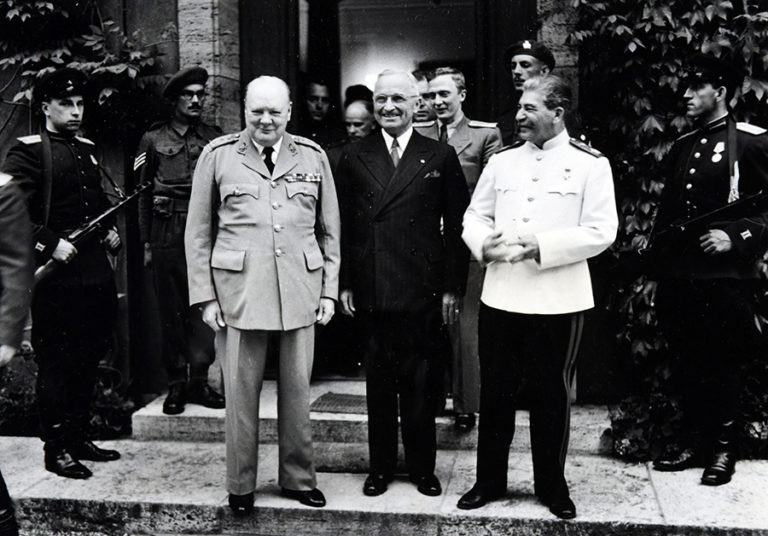
The Potsdam Declaration
The Potsdam Conference, which met from 17 July to 2 August 1945, was held in very different circumstances. Germany had been defeated, the Japanese Imperial Army had started crumbling and the United States had acquired the Atom bomb. The cooperation of the Soviet Union was no longer needed.
On 26 July, Churchill, Truman and Chiang Kai-shek issued the Potsdam Declaration, which outlined the terms of surrender for Japan. Stalin attended the Potsdam Conference but did not sign the Declaration, because the neutrality pact with Japan was still valid.
However, on 8 August 1945, two days after the atomic bombing of Hiroshima and the day before the second bomb fell on Nagasaki, the Soviet Union declared war on Japan. The news of impending war with the Soviet Union sent shockwaves through Japanese policy makers: just before he left Moscow for the Conference, Stalin had received a personal message from the Japanese Emperor, asking him to act as intermediary between Japan and the United States. The Soviet betrayal was an important factor in forcing Japan to surrender.
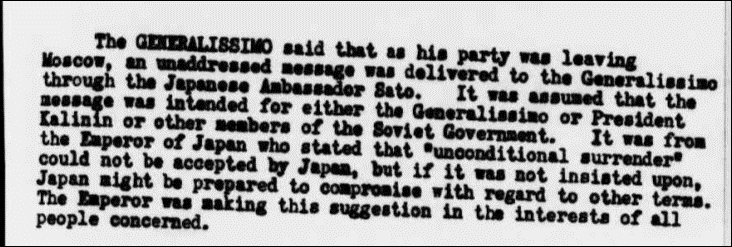
The Soviets launched their invasion simultaneously on three fronts in the east, west and north of Manchuria, the day after the declaration of war. Soviet forces also conducted amphibious landings in Japan’s colonial periphery: Japan’s Northern Territories, on Sakhalin Island. The Soviet landings in Sakhalin faced significant Japanese resistance, but gradually succeeded in consolidating control over the entire island. By the night of Tuesday 14 August 1945, the Japanese government had sent a letter of surrender. The American Secretary of State Mr Byrnes considered, on behalf of the Allies, that it amounted to satisfactory acceptance of the terms of the Potsdam Declaration.
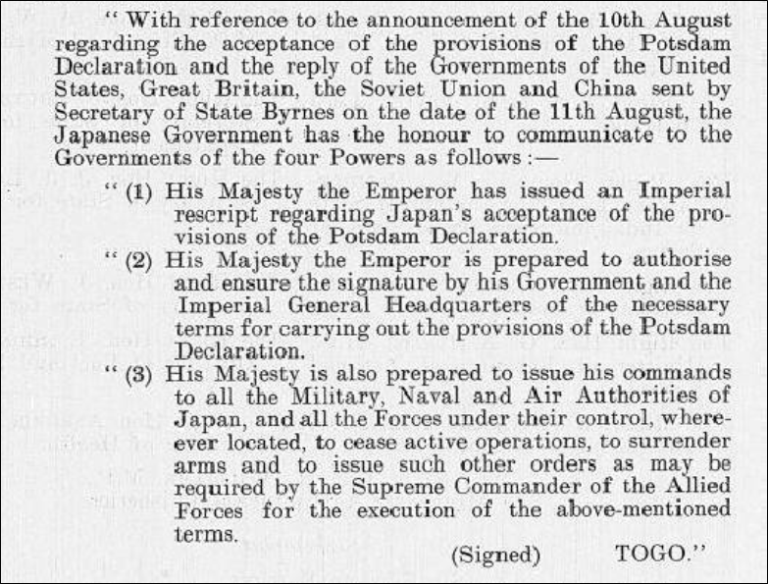
At 10:00 on 14 August 1945, as the situation deteriorated, the Emperor declared before his cabinet at the Imperial conference: ‘The military situation has changed suddenly. The Soviet Union entered the war against us. Suicide attacks can’t compete with the power of science. Therefore, there is no alternative but to accept the Potsdam terms.’
While the Emperor had an audience with his cabinet, a military coup was attempted by a faction led by Major Kenji Hatanaka. The rebels tried to seize control of the imperial palace to stop the Emperor announcing the surrender, but they failed and the coup was crushed shortly after dawn.
At noon on 15 August, Emperor Hirohito’s voice was heard on national radio for the first time. He announced the Japanese surrender. On Sunday 2 September, High-ranking military officials of all the Allied Powers as well as representatives from the Empire of Japan were received on board the USS Missouri. Just after 09:00 Tokyo time, the Japanese Foreign Minister Mamoru Shigemitsu signed the Instrument of Surrender on behalf of the Japanese government and General Yoshijiro Umezu then signed for the Japanese armed forces. US General of the Army Douglas MacArthur, the Commander in the Southwest Pacific and Supreme Commander for the Allied Powers, accepted the surrender on behalf of the Allied Powers and signed in his capacity as Supreme Commander. This was the conclusion of the war in the Pacific and the official termination of the Second World War.
I agree 100%!
Why am I 76 years of and learning of this Soviet factor for the first time? Truman told us if we didn’t nuke Japan that we might lose a million men by invading Japan. He lied. We did not have to nuke Japan. The nukes were a not so subtle warning to the Soviets. For shame!
The decision to use the bomb was also influenced by the fact had the war continued with Russia advancing, Russia would have had a say in the surrender agreements. That would have been a disaster for Japan and greatly increased communist influence in Asia ( consider the effect of Russia in East Germany). A ground war in Japan rather than the bomb would have cost more lives being lost by the Japanese, Russians and more importantly the Americans. The U.S. lost circa 112,000 in the Pacific. The object was a quick end of the war and limit U.S. loses.
Even if Russia entered the war, without the A-bombs, the United States would still have had to invade and a million AMERICAN men could have been lost. Also, the Soviets would have lost a large number of men as well, so the A-bombs DID help to end the war and the Soviets participation was simply a “land grab” by Stalin who wanted the same for Japan as he foresaw for Germany. Truman and McArthur stood firm against him and he didn’t get his way in Japan.
James Lutzweiler – this is because the USSR’s attack on South Sakhalin was an irrelevance.
It also started AFTER the atomic bomb destroyed Hiroshima.
South Sakhalin was part of Russia, grabbed by Japan after it soundly defeated the Russians in the war of 1904-05. Russia wanted it back, along with outer Manchuria.
To actually threaten Japan would require a navy.
A proper one – something Russia has never had. That’s why they lost in 1904-5, why the British navy had to escort the lend-lease convoys to Russia and why the Moskva is now on the bottom of the black sea.
Russia’s invasion of Japan 2 days after Hiroshima is interesting timing: Stalin could do a land grab given that the US had and would use a new weapon to defeat Japan. On the US side, the new bomb created internal pressure to try it out. And the US could now defeat Japan without Russia’s help – a big incentive. What’s the truth behind these August 1945 decisions by the US, Russia and Japan? Was it politics or saving US U.S. soldiers’ lives as to why we needed to drop the two atomic bombs. Still unsettled history.
Lutzweiller also doesn’t consider the daily toll of death and morbidity on Japan’s POWs, due to horrible mistreatment, punishment, torture, and starvation. Any shortening of the war should thus be considered on humanitarian grounds. Furthermore, Lutzweiller fails to acknowledge that even after Nagasaki and the Soviet declaration of war, Japan’s surrender turned out to be very tenuous. And, the final thing Lutzeiller fails to acknowledge is that he has the benefit of viewing all this in hindsight, which President Truman obviously could not have.
The primary goal of the development of A-bomb was to catch up Germany in the field of A-bomb creation and defeat it. In these times it was widely spread that Germany is ahead in cca 1,5 – 2 years, but they (allied inteligence) didn´t know that in Germany was not the joint strategy used and therefore basic research was fragmented to several directions. Also A.Hitler as a supreme leader assesed nuclear physics as a mean of jewish science and therefore it was strictly against it.
As Germany was defeated by traditional means of warfare before the initial test of A-Bomb there were rumours that besides primary goal (to force japanese military forces to surrender) was also very importat goal indeed – to send a message to soviets that US and western allies have a very powerful weapon and therefore it might be used in newly rising cold war.
Main fear of soviet invasion to norther japanes territory (Korea, China, Kurils islands) was that Red Army could cover a huge lands in continental China, Korea and spread of influence of communism (asi it was resulted from conference in Potsdam)…
It is of historic note that the Samurai Warrior code also affected the Japanese leaders. In short, to save face and honor is more important than winning or losing a war. Stories of Japanese servicemen staying and surviving in the jungles decades after the September 2, 1945 declaration of the end of WWII, are examples of the Samurai Warrior code. As much as we in 2023 hate to admit it, a swift end to WWII benefited the East and the West.
I total lu agree with Bart Solari, the two bombs were used to finish the war quickly and stop the Soviets who had already invaded Sakhalin and were going to do in Japan what they did in East Germany which became their satellite. It was really essentially about the control of the Pacific. In fact, there is always the simplistic story to tell the people and the real deep reason to share with a small elite.
Excellent website for the history. Note dates: Stalin promises at Yalta to attack Japan 3 months after end of WW2 in Europe, which turns out to be August 8, 1945, two days AFTER Hiroshima, when USSR declared war on Japan. Thus, Japan was boxed in, now with two powerful adversaries. Hirohito didn’t surrender until 6 days later. Not clear if the bombs were the critical factor or massive conventional warfare.
My negative opinion on the use of atomic weapons on Japanese civilians was hardened when for the first time I learned that six of the seven leading military commanders were all opposed. Admiral Leahy, Chairman of the Joint Chiefs of Staff and Truman’s military advisor, wrote in his Memoirs
“It is my opinion that the use of this barbarous weapon at Hiroshima and Nagasaki was of no material assistance in our war against Japan. The Japanese were already ready to surrender due to the effective sea blockade and the successful bombing with conventional weapons.
Eisenhower expressed his opinion in an interview after the war:
“First on the basis of my belief that Japan was already defeated and that dropping the bomb was completely unnecessary, and secondly because I thought that our country should avoid shocking world opinion by the use of a weapon whose employment was, I thought, no longer mandatory as a measure to save American lives.”
“It was my belief that Japan was, at that very moment, seeking a way to surrender with a minimum loss of ‘face’. The Secretary was deeply perturbed by my attitude.”
Nimitz, who also mentioned the blockade, MacArthur, Navy CNO King, Commanding General of the Army Air Forces Hap Arnold were all opposed. General Marshall was in favor.
As Eisenhower hinted, the Japanese had been pursuing peace feelers since the horrendous incendiary attacks on the homes of the Japanese in the spring. Unclassified documents revealed that every morning Truman was briefed on the status of the feelers. Tragically for the Japanese, they chose Russia to broach the peace feelers, and Russia did not want the war to end before it had a piece of it.
Sieges and blockades are among the oldest military strategies for forcing surrender without heavy loss of life. Japan could neither feed or heat itself. It had no capital ships remaining and few military aircraft. No other nation in the world believes that using the atomic bombs saved lives.
With all of the lost lives in the bombing of Tokyo, if Japan was ready to surrender, why didn’t it. The Army would have continued fighting to the last man. The US had to make it clear that it was useless to continue fighting. One bomb was dropped. No surrender. That means the Japanese were OK with losing a whole city. So, another one was dropped. Terrible, yes. But, the only other way was to invade Japan at a massive loss of life to US and Japanese lives. The Japanese people were willing to die for their Emperor and would have except their leader finally told them they were surrendering. As much as we would like to think there was an easy way to win the war, there was not. Years after the war, we do not begin to realize the cost to America these two wars had been. It needed to end and it did. This debate will go on and on with two sides fighting it out. However, the results were the end of the war and saving a lot of lives.
Putting aside the “failure to acknowledge the benefit of hindsight which Truman obviously did not have” (a truism that applies to each of us commentators), this back and forth about the Soviet invasion versus the nukes could stand a re-visit to the United States Strategic Bombing Survey, particularly its thorough review of strategic bombing successes and failures. Time and time again aerial bombardment has proven to be ineffective at terminating hostilities. The March 1945 Tokyo bombing campaign cost Japan 80,00 lives but provoked no suit for surrender. The Survey concluded that even without the nukes, the Soviet declaration of war, and a plan for invasion, Japan would have thrown in the towel in 1945. This is not having the “benefit of hindsight”; Truman knew at the time that as severe as the March bombing of Tokyo had been, it brought an armistice no closer.
Why did this even happen
“Japan was, at that very moment, seeking a way to surrender with a minimum loss of ‘face’”
The Nukes were the best opportunity to surrender – NOT because of Japanese defeat, but Barbaric US worst War Crime over civilians in History 🙁
Did the Japanese high command immediately realize that the bombing of Hiroshima was something so different from the bombing they had already been undergoing?
Or was it a bit like the Aztecs trying to make sense of the landing of Cortez?
I would like to know more about the Soviet invasion of Japan. My father was a prisoner of war in Japan in the Sendai area. I have been undertaking family history and have just learnt from my mother that the Soviet soldiers arrived in camp, some of them on horseback. At the time dad was in the area of Ohashi. I have searched on the internet and cannot find any information.
Truman chose to save lives and end the war, as transcripts now reveal. Soviets declaring war 2 days after the 1st bomb have no bearing on Japan’s decisions- as Stalin just wanted more land in Asia. Pearl Harbor, and then the vehement suicidal approach of Japanese military, resulted from a race to beat Hitler developing the horror. We can, and will, speculate- but thousands of American military came back home as a result…
US original estimates for casualties by invasion of the Japanese home Islands was 50,000 dead. Propaganda embellishments over the years increased those numbers to 100,000 200,000 500,000 and here we see 1 million casualties. All in an effort to justify the use of the nuclear devices.
There is a definitive narrative that makes sense but excludes many individual triggers that resulted in the actual surrender. However, we know the defining point when no further decision making was necessary by anyone: emperor’s surrender.
There is little doubt Russia wanted reclamation & more by seeing a chance, if not expedient, due to several factors by declaring war:
1. Nagasaki bombing
2. Malta conference where noe Russia may loose a bargaining chip & needed to act faster.
3. 2nd bombing
4. US Supreme commanders personal desire to drag out surrender by siege: prisioner & more lives lost but a ‘safer’ if not calculated bet.
5. Truman’s state of mind knowing all the above.
It was his call & that’s the key to putting a period to much debate. He had a choice & his logic is all that counts.
WWU do?
Former US Navy line SWO Officer